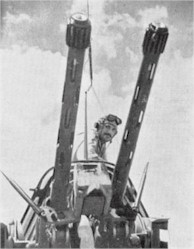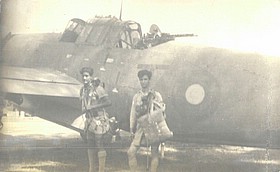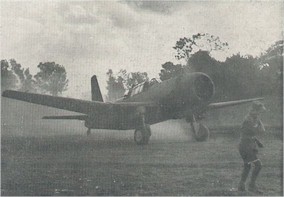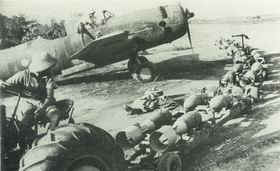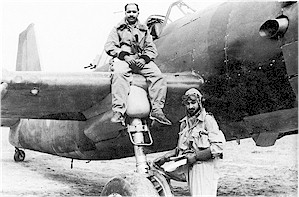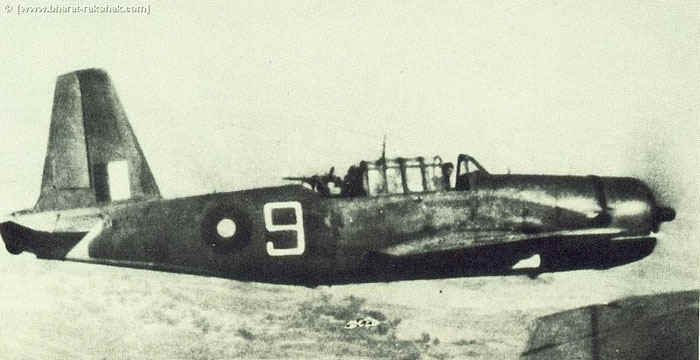
Vultee Vengeance belonging to the 151 OTU at Peshawar
Forgive my musings on one of the most unsung aeroplanes of the war, the Vultee Vengeance. I thought it might be a good idea putting together whatever little trivia I’ve gathered about the aeroplane (and there’s precious little, indeed !), as also hangar tales told to me years ago, usually on horrendously rainy nights from Calicut to Bombay by Vengeance pilots and observers, drink in one hand, cigarette smoke lazily curling up, to rapidly spin into a whirring fan-blade, only to be brought down again into an all-encompassing, aromatic, tobacco-haze. The hiss of the rain through the palm trees transporting us to another place, another time, the lined face in front of you suddenly crinkling his eyes, once again young, shining, peering once again through the clouds and rain, looking for that bridge, that Jap column, that Oscar, or even Uderbund and home, hands gesturing in the timeless dance of the aviator as tales are recounted, the past as much a part of the present, as the present itself. Where did the concept of the Vengeance dive-bomber start? For that, we need to step back and see what was happening in Germany.
The Dive Bomber Concept
The Junkers 87 Stuka (Sturtz [dive] kampf [war, or bomber] flugzeug [aeroplane]), was the 62-victory, First War, Blue Max winner, Ernst Udet’s baby, after he had witnessed the American Curtiss Hawk II (known as the Helldiver) bi-planes in 1931. When he became the Inspector General of Fighters of the Luftwaffe, thanks to his friend and fellow Blue Max winner, Hermann Goering, he advocated the concept of the dive-bomber (absolutely correctly, as history subsequently proved), with the same passion that he put into his aerobatic displays and his cartoons (he was a great cartoonist who used to draw brilliant cartoons on table-napkins for any young lady who’d currently taken his fancy – by all accounts, in the case of this fascinating pilot’s pilot, the fancy was usually mutual !). This was notwithstanding the fact that Wolfram, Freiherr (Baron) von Richthofen, the head of the Reichsluft Technischenamt (Technical Office) at the Reichsluftsministerium (Air Ministry) was dead against the concept of any aeroplane diving below 6000 ft. agl because of the hazards of exposure to ground fire. Wolfram, by the way, was the cousin of Manfred, Freiherr von Richthofen (the Red Baron), who was killed on the 21st. April, 1918, whilst trying to save the newcomer Wolfram from the guns of Capt. Arthur Roy Brown, who, in turn, was trying to save his class-mate and newcomer, Wilfrid May, from Manfred’s guns. Both had respectively told their wards to stay away from any trouble (read ‘combat’ ). Neither listened (does anyone ever?!!), and Manfred lost his life, either to Roy Brown or the Aussie infantry, still a fascinating subject of intense debate and speculation, 85 years on !
Anyway, the Stuka, designed under the leadership of Junkers’ Hermann Pohlmann, was capable of 90-degree dives, with a window below the cockpit floor to give full visibility of the target and the pilot’s left-side window graded with markings of 60, 75, and 80 degrees. Following a horrendous accident in Aug ’39 when most of StG (StukaGeschwader) 76 under Hauptmann (Capt.) Walther Siegel hit the ground during an exercise in Neuhammer in Germany when cloud-base estimates went terribly wrong (familiar experience, anyone ?!), followed by the experience of the Blitz in Flanders and France, the Stuka was equipped with an automatic, barometer-linked, pull-out device, wherein the pilot, once he’d put his aeroplane into a dive, would pull out at a certain height, no matter what the level of his disorientation. It was, in effect, something that would actually action what would now be your typical GPWS “Pull up, whoop-whoop!!” recorded message (not a bad thought for air safety today, on the lines of TCAS, only much more simple and focused, and therefore, arguably, more workable).
Enter the Vengeance
The English wanted a dive-bomber, after their experience in the Low Countries and France, so Vultee of the USA designed the Type 72 Vengeance, equipped with the Wright Cyclone R-2600 twin-row 14-cylinder radial engine delivering 1600 hp (Mk. I-III). The IV, which equipped our 7 & 8 Sqns., (although the Official History of the IAF states that 7 Sqn. received Mk. III’s, and this statement appears to be more correct as several photographs, some even on the B-R site, depict twin 30’s, one of the external identifiers of the aeroplane as a III, at the back of the a/c) had a R-2600-19 engine with 1700 hp. It first flew in July 1941, 5 1/ 2 years after the Stuka had first flown. By the time the RAF received it, they had realised that it could only be operated in theatres where they had air superiority, so the Burma theatre in 1943 was (arguably..!) the logical choice. A quick comparison between the two aeroplanes may help put the two into perspective :
| Junkers 87-D Stuka | Vultee Type 72 Vengeance IV | |
| Engine | 1300 hp Jumo 211J | 1700 hp Cyclone R-2600-19 |
| Weight | 14500 lbs | 15600 lbs |
| Span | 50 ft 1/2 in | 48 ft |
| Length | 36 ft 5 in | 39 ft 9 in |
| Height | 12 ft 9 in | 14 ft 6 in |
| Wing Area | 344 sq. ft.(D-1)/ 363 sq. ft.(D-8) | 332 sq. ft. |
| Max speed | 250 mph | 273-279 mph |
| Ceiling | 24000 ft | 22000 ft |
| Range | 620 miles | 600 miles |
| Wing Loading | 42. 15 lb/ sq. ft (40 lb – D-8) | 47 lb/ sq. ft |
| Power loading | 11. 15 lb/ hp | 9.18 lb/ hp |
| Armament
|
2 X 7.92 mm MG 17’s in the wings 2 X 7. 92 mm MG 81’s Observor |
4 X .30’s in the wings (1-III) 2 X .30’s for the Observer (I-III) 4 X .50’s in the wings (IV) 1 X .50 for the Observer (IV) |
Whilst the figures above may indicate similar performance (with the Vengeance perhaps even appearing to be a shade better), it can be argued that the Stuka was the better aeroplane – it could dive at 90 degrees and release its bomb with complete impunity to the propeller as its bomb was carried in a cradle which dropped down to a position outside the arc of the prop before release and ensured that it was not endangered. Needless to say, this was a perfect recipe for spot-on accuracy. The Vengeance, on the other hand, could also dive at between 85-90 degrees (the Observer’s seat was turned to face forward before diving), and although the bombs fell from regular belly bomb-doors, two bombs were placed side-by-side, mounted on crutches, which swung down, Stuka-fashion, in order that the bombs would clear the arc of the propeller. Whilst this is pure speculation on my part, I wonder which was the more easy aeroplane to dive-bomb with – the Vengeance, a thousand pounds heavier, with bomb doors that opened, disturbing the airflow, and two bombs, side-by-side, swinging out on crutches, or the Stuka, with its more simple system…..
I remember Air Cmde Sathyanarayana [Sathi], who flew Vengeances in 7 Sqn, telling a wide-eyed 11 year-old in my father’s railway saloon in Secunderabad in ’65 how the trick was in pulling out of the dive at the right moment after bomb release in both, a Vengeance, as well as in a Hurri, to ensure that you didn’t qualify for wings on the shoulders and a harp ! In fact, the accuracy of the Vengeance in the field becomes all the more praiseworthy, when you consider the fact that the Vengeance technique is closer to skip-bombing than dive-bombing. However, in view of the facts given in the previous paragraph, it is probably only the writer’s memory playing tricks, and Sathi would only have said this of the Hurri, and not the Vengeance !
Another interesting comparison between the Vengeance and the Stuka – Stuka pilots like Hans-Ulrich Rudel (amongst several others) had actually downed enemy aeroplanes (Rudel had got 519 tanks, sunk the battleship ‘Marat,’ sunk one cruiser, one destroyer, 70 landing craft, 4 armoured trains – and – shot down 9 aircraft – all Soviet), whereas I have not heard of any IAF, RAF or RAAF pilot downing any enemy aeroplane, notwithstanding the four .30 Brownings (Mk. III) or the four .50 Brownings (Mk. IV) in the wings.
| The ‘inseparables’ of No. 7 : ‘Dolly’ Engineer, Manohar Sakhare, Joe Ezekiel and Keki Gocal browse thru a magazine. |
Joe Ezekiel of 7 Sqn. said (in ’93, when I met him at his home in Bandra) that when the Vengeances first came to the Squadron, they acquired the reputation of widow-makers as they had a tendency not to pull out of dives – embarrassing, I would imagine, for a dive-bomber! One of the pilots who crashed in this manner was Dayanand Bhavanishankar Kagal, whose daughter was born posthumously. His sister-in-law, Carmen, says that Dayanand’s younger brother, Nandan, who was a well-known journalist, was extremely bitter about the fact that pilots were asked to fly an aeroplane which was not fully/ properly tested.
This is borne out by Joe Ezekiel again : He said that the Powers-That-Were sent an RAF hot-shot pilot (a Sqn Ldr) to explain to the Natives (he apparently thought little of the Indian pilots) that the Vengeance was perfectly safe to pull out of a dive, no matter what. He apparently called all the pilots together and harangued them, and questioned their courage, and technical capabilities, equally. He then walked out to the nearest Vengeance, started her up, taxied her out, took off, climbed to 10, 000 ft, deployed his dive-brakes (which consisted of open-ribbed flaps, on both, the upper as well as the lower surface of the wing, just forward of the ailerons, the top one opening in a similar fashion to that of the Boeing 737’s air brakes, only upward and backwards, not forward), dived, and……….well, just – dived ! The subsequent accident inquiry revealed that the Centre of Gravity (CG) of the aeroplane was too far forward without an Observer/ Ballast in the rear seat, causing it to get into a terminal dive, irrecoverable even with full nose-up trim (simple and obvious, perhaps, but the obvious has always had the knack of staying chimeral !). Needless to say, subsequent soloes at the OTU at Peshawar, passed off smoothly with the pilots getting into dives with ballast (or a supremely happy or terrified passenger – although it was usually ballast, I believe – solo, remember -opinions/ corrections most welcome, please) firmly strapped to the rear seat !
Indian aircrew at a forward airbase with a Vengeance . Photo courtesy : Air Force History Cell
A Vengeance taxying at an airfield in Assam
Cecil Naire (his full name was Cecil Henry Naire) came from Trivandrum. His father was a Nair, married to an English lady, and the father changed the spelling of the family name to Naire. Cecil and his sisters (one’s name was Madge – the other one’s name was Maggie, I think, but I may be way off) were educated in London. When he came back, he started teaching mathematics at the Maharaja’s College in Trivandrum. When war broke out, he applied for the IAF. He said he didn’t make it for pilot training on Tigers, and was naturally sent for Observer training because of his mathematics background (he said that he was actually washed out of pilot training because, in ’41, he was an ‘old’ man of 25 !!). Cecil, when I knew him from ’79 – ’81 in Calicut, always, always, used to say that he was an Observer, NOT a Navigator, and always wore his ‘O’ wings, and not the later ‘N’ ones.
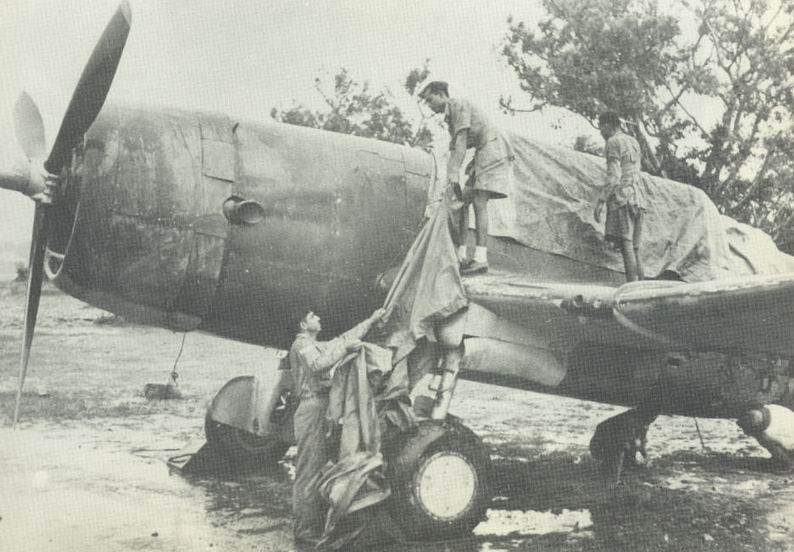
He told me tales of flying over the Burma hills, having to be especially wary of the katabatic currents which would pull the unwary into the mountains (how I used to think of him whem flying over the Nagalapuram and Nagari hills near Tirupati, low, my mind’s eye peering out of a Vengeance or a Hurri windscreen !). His sister (not Madge) was the one who taught me to sing ‘Coming Home on a Wing and a Prayer’ as well as the danger of either singing or playing Cole Porter’s ‘Night and Day’ ever, ever, when amongst fliers, as someone or the other would crash the next day if this particular song was played in the Mess or anywhere else.
A Vengeance undergoes maintenance at a forward airfield in the CBI theatre. The Subcontinental monsoons turned the forward airfields into a quagmire as can be seen in this picture. Pic Courtesy : Imperial War Museum, UK
He told, one late night, how two brothers died the day after the song was played as a prank in the Mess by some army types. His niece, Pammy, would play the record if she particularly wanted to irritate him, and he would emerge, Jehovah-like, from his room, to snap the damn thing off – yet – strange…he never, ever, got rid of the record ! He said that that their quarters (tents/ bashas) were far away from Uderbund and that PC Lal would personally wake up his boys at 0300 hrs, winding up and setting off an alarm clock (the modern electronic ones are merely a wimpy “beep-beep” shade of their forebears !) outside each tent until the sleepy, bemused heads within peered through the flap, before making a scramble for the basha’ed ditch that served as the loo and getting ready. They had to drive many miles to the PSP (Pressed-Steel-Plate) field at Uderbund, a two/ three-hour drive through some of the most horrible, monsoon, slip-sliding slush imagineable. Cecil, when I knew him, was a tall (about 6′ 2″), broad-shouldered, narrow-waisted bachelor, who’d left the IAF to join the Indian Frontier Service in the early ’50’s – possibly ’53 or thereabouts, like his compatriot, Murkoth Ramunny. He was English in every way (he “spowke laaik theyat!”) and yet, passionately proud of his Indian-ness.
He talked of how the 7 Sqn. boys were given Uderbund, whereas 110 Sqn. (he used to call it “Won Won Owe”) RAF, were living in a proper, permanent-structure Mess in Kumbhirgram (modern-day Silchar). Cecil told of how once someone from 110 Sqn. made a rude remark about the Indians – that night, the jeeps from 7 Sqn raided 110, broke up stuff in their Mess, hammered their boys, and after that – surprise, surprise, they became the best of friends ! Cecil and Joe Ezekiel both separately talked about how Dolly Engineer, with his Observer, KPK Menon, had a tyre-burst on a shard of torn PSP one horribly rainy morning in ’44 with a full 15, 600 lb aeroplane plus a 2000-lb bomb-load. The aeroplane metal-banshee-screeched and skidded out of control, until she finally slammed against a bund. Everyone on the ground froze and waited for the inevitable dull-boom-pyre, but, lo and behold…..two figures ran safely away before that could happen ! Everyone, but everyone, had thought they were goners……!
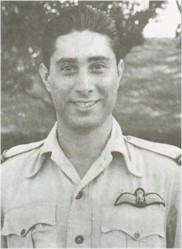 Dolly Engineer was a fascinatingly controversial figure. My father’s friend, Gp Capt Darashaw Lawyer, who was an Engineer Officer in the RAF (he thinks it was 910 Group, RAF, but isn’t sure), says that Dolly had joined the Engineering College in Poona, but used to bunk most of the time ! Dolly was also a bit of a Jonah, as he appears not to have had too much of kismet. Joe Ezekiel spoke of how Dolly, once, on the way back to Uderbund with Sgt. Ball (an Anglo-Indian) as his observer, got lost. Seeing a formation of American bombers (said to be B-25’s, although Joe said they were B-17’s [the official history says B-25’s]), he turned towards them. The Americans, thinking him to be a Jap (the Vengeance resembles a Japanese Type-97 Kate somewhat), blazed away at him (the ether must have been filled with American screams of “Oh my Gaaawd !!”) with scores of .50’s firing – only one bullet struck the Vengeance – unfortunately, it went through Ball’s head.
Dolly Engineer was a fascinatingly controversial figure. My father’s friend, Gp Capt Darashaw Lawyer, who was an Engineer Officer in the RAF (he thinks it was 910 Group, RAF, but isn’t sure), says that Dolly had joined the Engineering College in Poona, but used to bunk most of the time ! Dolly was also a bit of a Jonah, as he appears not to have had too much of kismet. Joe Ezekiel spoke of how Dolly, once, on the way back to Uderbund with Sgt. Ball (an Anglo-Indian) as his observer, got lost. Seeing a formation of American bombers (said to be B-25’s, although Joe said they were B-17’s [the official history says B-25’s]), he turned towards them. The Americans, thinking him to be a Jap (the Vengeance resembles a Japanese Type-97 Kate somewhat), blazed away at him (the ether must have been filled with American screams of “Oh my Gaaawd !!”) with scores of .50’s firing – only one bullet struck the Vengeance – unfortunately, it went through Ball’s head.
Later, after 7 Sqn. converted to Hurricanes, Dolly went on a ground attack sortie and didn’t return. Joe Ezekiel was one of the pilots sent to look for him. He said that he found Dolly’s Hurri – it had crash-landed and overturned, but he said that the damage looked minimal, the hood (canopy) was open and the straps hanging out. He assumed that Dolly had got out safely. They never found him, and Joe said that the story doing the rounds among the Indians was that Dolly had escaped to/ been picked up by, a INA unit and that he became the personal pilot of Subhash Bose. Joe told me that he thought that Dolly had been flying the Mitsubishi B-1 Betty bomber in which Bose crashed in Formosa in 1945. I have not heard this story from anyone else, but it’s fascinating, nevertheless !
Cecil had always spoken of his friend Jamsu Dordie and I naturally had to meet him, as also his friend from the Path-Finder Force [PFF] Fg Offr ‘Suki’ Sukthankar, DFC., the ex-Commissioner of Bombay, whom I spoke to upon my return to Bombay in ’80, but never met – he died (I suppose this is the reason for my current rantings – put it down, for what it’s worth, warts an’ all, else it doesn’t get recorded, ).
I met Jamsu one afternoon in mid-’95, at the US Club in Bombay, thanks to my fellow-aviator, Bobby Dubash. Jamsu was from St. Xavier’s School, Bombay, and was an ex-schoolmate of Bobby’s. He was in St. Xavier’s College, when he joined up, I think, in ’41 (Bobby couldn’t join as his eyes went bad shortly thereafter – he flew a Piper Super Cub like a Spitfire, though, sheer poetry in motion, and I had the privilege of taking his ashes aloft 6 years ago – he died of lung cancer – he never smoked, so I guess there’s a lesson in this somewhere !). Jamsu told of the time he baled out in ’44, thereby becoming a member of the Caterpillar Club. Pushpinder Singh, in his ‘Battle Axes,’ gives the date of this crash as 1/ 5/ 44. Jamsu, when I met him in ’95, said that the date was actually 1/ 4/ 44. He had good reason to remember – he had taken off on a doomed flight, on a raid to Kalewa as part of a six-aircraft raid, his pilot being Fg Offr Eduljee H Dadabhoy (from Dadar Parsee Colony). The weather they encountered was completely and horribly unexpectedly, bad (the Met reports were duff). Jamsu said that Edul told him that he was going to invert the aeroplane so that they could bale out. He did so. Jamsu jumped. They never found Edul Dadabhoy. The Official History of the IAF (pg.123) says ‘On 1 April one pilot who was in a party of 6 aircraft which were returning from an unsuccessful mission due to bad weather conditions, crashed in a valley west of Imphal and was killed. He had however made his navigator bale out before crashing and this officer came back to Uderbund on the 3rd’. (Jamsu said that it was the 4th.)
Naushad Patel, son of Wg Cdr Hoshang Patel, has sent this fascinating email about Edul Dadabhoy, which I’m reproducing as I received it, else I fear it will lose its soul !
“Dadabhoy was a course-mate of dads (Wg Cdr Patel’s), and he seems to recall he was from Madras because he once overheard him barging some rude Tammu’s in fluent Tamil. Apparently he was a fine chap, well educated and eloquent and very tough to boot – also a bit eccentric like us all.
He was once flying as a trainee and the instructor, who was the rao-raja of some Rajasthan state was one of those anglofied types who had nothing but nasty things to say about the natives – anyway, they were on this flight in a Harvard and the chap said something nasty again. Dadabhoy apparently told him to mind his tongue. The Rao got annoyed and told him to watch it, whereupon Dadabhoy nosed the stick full-over and held it down saying “If you dont apologise immediately, I’m going to take you with me”.
The chap held back as long as he could, but finally blurted out an apology.
“I didnt hear you, what did you say??”
“Sorry”
“Still cant hear you, speak up “
“I’M SORRRRY!!! “
Moral is – never tangle with a crazy bawa or an Iroon!
When they got their wings and were celebrating in the mess, this same chap walked in, took one look at Dadabhoy and stalked out. Dadabhoy’s comment “He was born and raised in England, but unfortunately only passed thru Oxford, and that too, in a tonga!”
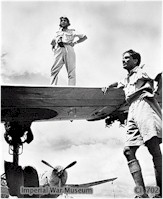 |
| Sqn Ldr PC Lal and Fg Offr M M Sakhare pose by their Vengeances. |
Cecil told me that when Hem Choudhry was the CO of 7 Sqn,. he used to make the Bengali boys sing “Jodee taaray daak shonay keoo noy aashay tobay ekla cholo ray” which was a Tagore song (‘when you call and nobody listens, then walk alone, ‘ – one of Gandhi’s favourites). Hem was the brother of the later Army Chief of Staff, Gen J N (Joyonto Nath) Choudhry, of the 7th. Light Cavalry. Hem (like all the other Indian boys) had this supreme pride in the IAF – it didn’t have to be the best – it was the best ! Hem was a box-wallah from Calcutta (from, I believe, Shaw Wallace – corrections appreciated, please ). He was an Auxiliary officer who fell to his job with the passion and the enthusiasm that only the passionate amateurs (arguably !!!) can bring with them !! Cecil told of how Hem would start a typical, Calcutta, wild, box-wallah evening, full of song and cheer, until the wee, wee, hours of the morning. And woe betide the poor sod who wasn’t on time for the dawn briefing, red-eyed, perhaps, but there, nonetheless !!
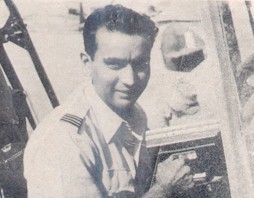 |
| Sqn Ldr Pratap Chandra Lal DFC in the cockpit of a Vultee Vengeance bomber. |
Both Cecil Naire and Joe Ezekiel had nothing but the highest praise for both, Hem and PC Lal, as leaders of men. As a matter of fact, both of them said that 3 drinks an evening was probably the most they would imbibe ( also think of these boys at that age and stage – they were, in the main, little more than babies, older or younger, largely younger, I’d suspect (!), than most of our sons). Cecil spoke of how, one evening, when he and Sathi had just landed, Hem asked for a volunteer crew to bomb a Jap column crossing a bridge. They volunteered, attacking the bridge at close to last light (he said they got the bridge) and landed at dark. One can only imagine the high level of airmanship, both, pilotage and navigation, to get them back, in the dark, into a PSP airstrip in the middle of the jungle. In December ’97, whilst at dinner with his son Pradeepak in Hyderabad, I scanned Sathi’s log book, and wondered which sortie was the one Cecil had described….
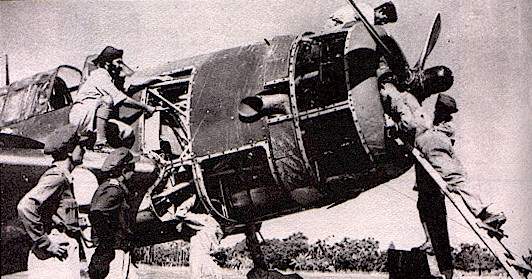
Hem was to die after the War in a Tiger Moth, with the US attache’s wife as a passenger, when he dived into the Hooghly whilst flying low. Hem’s spirit was the same as that of his compatriot, Laddie Roy, DFC, who’d been killed on 22. 7. 18, the only double-ace from the sub-continent, at the age of 19 (Subroto Mukerjee was Laddie’s nephew). For those interested, there were five Indians who had served as pilots in the Great War – Indra Lal ‘Laddie’ Roy, Hardit Singh Malik (who was the first officer to be commissioned in the Indian armed forces), SC (SG ?) Welingkar (who was Hrushikesh Moolgavkar’s relative), Errol SC Sen (who survived as a POW in the Holzminden POW camp), and Nowroji (whose details are as yet unknown to me) – only Malik and Sen survived.
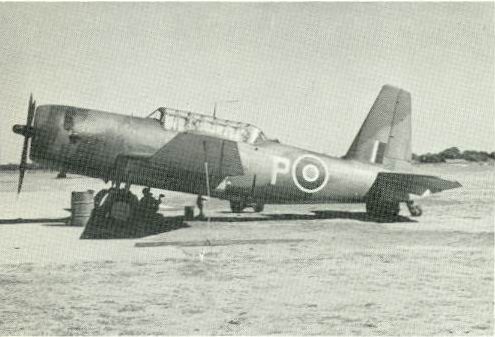
Vengeance of No.8 Squadron being refuelled at a forward airstrip. Since the rounels are Non-SEAC, the airstrip was probably in NWFP or Punjab. The photograph is from the collection of Hugh Seton, who was an RAF Pilot seconded to the 8th Squadron.
I met Phil Philips of 8 Sqn, a pilot, when he’d brought the Beech V-Tail Bonanza belonging to Dr. Bhave of Poona to Juhu Aerodrome in ’97. Dr. Bhave had actually taken his aeroplane to trace the entire route of Kalidasa’s ‘Meghadoota,’ some years ago. Phil Philips was a young-looking 76, and he told of how he’d served with 8 Sqn. on Vengeances. Their squadron was one of those ‘Commonwealth’ squadrons, where the ‘common wealth’ may not have worked too well, rather like the Bombay ‘co-operative housing societies,’ which, somehow, never manage to get the ‘co-operative’ bit quite right!
Sqn Ldr Niranjan Prasad CO of No.8 Squadron and his ‘Observer’ Fg Offr Jagjit Singh with thier Vengeance before going on a sortie
Fg Offrs G D Sharma (Later Air Marshal) and Sadiq proceed to thier mud splattered Vengeance in March 1944. Both flew with No.8 Squadron.
Niranjan Prasad was the CO, and it couldn’t have been an easy job. Phil Philips told me of a time when, as a very young man (about 18), he’d just walked out of his aeroplane to dispersal, when an English sergeant dared him to hit a can hanging from a tree with his Webley (Smith & Wesson? Colt?) revolver. Phil pulled out his revolver, fired and hit the can and, upon the call of “fluke,” fired, hit it again, twice more, and walked off, head held high, especially, Indian-high ! Phil was told by Niranjan Prasad that he’d recommended him for a DFC for completing the maximum number of (very difficult) sorties in the Squadron, and that night, there were celebrations amongst the Indians, drinkies for the rest, but badaam sharbat for Phil, who was too young to drink ! The timing was wrong, as Niranjan Prasad was posted out shortly thereafter, and the recommendation came to nought.
Joe Ezekiel told once of how he had landed at an airfield (it was not Uderbund – he didn’t remember which) and shortly after he’d landed, the airfield was under attack by Zeroes (Cecil also talked of Zeroes, and there may well have been Zeroes in the area then. However, it was more likely that this was a raid by Army Oscars, which were more numerous in this theatre of operations. The perception of the Zero as the generic Japanese fighter was as common as the perception of the Spitfire as the generic RAF fighter during the Battle of Britain, when young, tight, German pilots had, shouted into their ear, the cry, “Achtung Spitfeur !!” to sober them up quickly [‘Eagle Day by Richard Collier] !). He said that he and his Observer sat petrified in the aircraft, engine running, too petrified to run or switch off, while the Jap fighters lazily strafed the runways (not much use, I’d think, with machine guns !!) and the airfield.
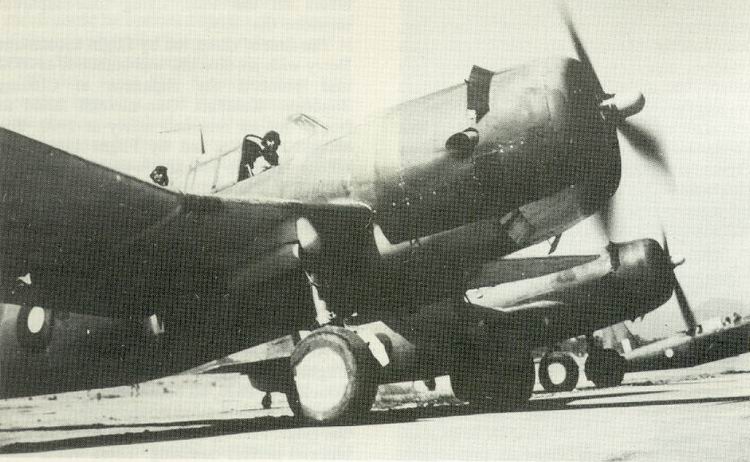
Speaking of Joe Ezekiel, there is a delightful story he told me of the time when he was a part of No.4 (Karachi) Coastal Defence Flight when they were based at Juhu airfield (home to the Bombay Flying Club since 1928) in 1940. Minoo Engineer was the 2 i/c and kept watching Flt Lt Sprawson, the CO, picking up the telephone and saying, in a clipped accent, “No.4 Flight, Sprawson speaking.” One day, when Sprawson was not in the office, the telephone rang. Minoo dutifully picked up the receiver and said, in his best Brit accent, “No. 4 Flight, Sprawson speaking.” The British officer at the other end of the line said “Ah, Sprawson…,” and started speaking rapidly to him on various issues… Horrified, Minoo stuttered “No, no, this is not Sprawson, this is Minoo ! Mee ee ee noo oo oo !!” Joe told me that, thereafter, he always called him “Mee ee ee noo oo oo!!!”
In conclusion, and in tribute to the Vengeance aircrews, I quote from Maj Gen Julian Thompson’s excellent book, ‘War in Burma 1942-1945’ (he was the Royal Marine officer commanding 3 Commando Brigade in the Falklands in ’82. A sound tactical and strategic thinker, who doesn’t think too highly of Wingate’s abilities, a view shared by ‘Joe’ Lentaigne, apparently…) : The scene is set in the Arakan in January, 1944, when tanks, Lee-Grants, were first going into battle against the Japanese. The quote is by a Capt. Rissik (pg. 90 of the book)
“Accompanied the general to a suitable vantage point, situated on a convenient peak of the Mayu range to watch the whole course of the battle. At ten o’clock sharp the first wave of bombers [Liberator heavies and Mitchell mediums] appeared, to schedule, over the target area and dropped their bombs with what appeared to be effect upon the Japanese positions. They were followed by Vengeances, whose accuracy, soon to become a byword, was all that could be desired.”
Ours or the Aussies’ or the Brits’………ours, more likely !!
I dedicate this contribution to my friend, Cecil Henry Naire……
Author’s Notes:
A brief comparison between the dive-bombing techniques of the Stuka and the Vengeance :
Vengeance :
a) Approach target at approx. 12, 000′
b) Target goes past trailing edge of wing (usually port)
c) Select bombs to ‘live,’ bomb doors open
d) Wing over into dive
Alternately
b) Open bomb doors and fly over target
c) Observe target through window on floor
d) When target directly below half-roll into dive
e) Select dive brakes and dive at 70-90 degrees
f) Terminal velocity speed in dive approx. 320 mph
g) Release bombs at 4, 000 – 3, 500′ agl
h) Retract dive brakes and initiate pull-out 3, 000′ agl
f) Complete pull-out by 500′ and exit or engage ground targets with guns
Stuka :
a) Approach target at approx. 13, 000′
b) Target goes past trailing edge of wing (usually port)
c) Close radiator flaps
d) Supercharger off
e) Wing over and half-roll into dive
Alternatively
e) Stick forward into dive
f) Set angle of dive 70-90 degrees(red lines showing various angles marked on canopy side panels)
g) Accelerate
h) Apply dive brakes
i) Release bomb 1, 600′ agl
j) Retract dive brakes, open radiator shutter, supercharger on, initiate recovery
k) Recover around 700′ agl and exit or engage target with guns
Readers will note the similarity of techniques, as also the following differences, in that the Stuka released its bomb from a lower height whilst executing recovery at a greater height (the latter advantage is arguable, as a higher aeroplane at low speed is possibly under a greater threat to ground fire).
What was the Vengeance like to fly ?
For excerpts, I quote from the book ‘Vengeance!,’ by Peter Smith which, I think, is the only reference book on the subject till date !
Report by RAF test pilots in the US (page 31)
“This aircraft is very easy to fly and land and gives the pilot a feeling of confidence. It has a fair performance but the take-off and initial rate of climb are sluggish. The controls, with the exception of the ailerons, are on the heavy side but the aircraft has no vices and the dive brakes are particularly good……and reduce the diving speed to a little over three hundred miles per hour. They do not cause changes in longitudinal trim and have no adverse effect on the flying controls…….having a large diameter radial engine the forward view is inferior to the comparable German type and this is more of a handicap during take-off and landing than in dive-bombing. Greater accuracy in dive-bombing would result were the flying controls improved. The ailerons are light and effective, but directional control, once the aircraft is committed to a dive and has gathered speed, requires adjustment of the rudder tab.”
Northrop’s Chief Test Pilot, Moye Stephens, 1941 (page 36)
“My initial impression was there was something inherently wrong with the ship. Included in its peculiarities was the British requirement of zero angle of incidence to facilitate dive-bombing. It was possible to dive straight down with a minimum degree of tuck-under; but, as a consequence, the ship’s nose-high attitude in level flight effectively blocked out vision straight ahead. Among other novel first-flight impressions was an erroneous notion that the indicated airspeed had to be unbelievably modest.”
Recommended RAF diving procedure (page 52) :
“At pull-out, if dive brakes are retracted at the start, more height is necessary for recovery but elevator control is lighter than if the dive brakes remain extended throughout the recovery. The extra speed gained by early retraction would be an added asset in getting away quickly.’
Canadian pilot, Bud ‘Red’ McInnes, 110 Sqn, 1943 (page 102)
” We knew, of course, that the aircraft had been constructed for a truly vertical dive. To my knowledge, it’s the only aircraft that was, because, having no incidence, the aircraft did not creep, so, theoretically, a perfect dive would be possible.”
The correction of certain inaccuracies which were there in the article as I had originally written it, have been thanks to reference to Peter Smith’s ‘Vengeance,’ which was sent to me subsequently by my friend, Simon Watson of the Aviation Bookshop, London. My gratitude for being able to use Peter Smith’s book as a reference, and my thanks to Simon Watson. As mentioned earlier, I shall be most grateful if any reader could provide me with point me to Vengeance Pilot’s Notes.
Copyright © MUKUND MURTY. All rights reserved. Reproduction in whole or in part in any form or medium without express written permission of MUKUND MURTY is prohibited.
